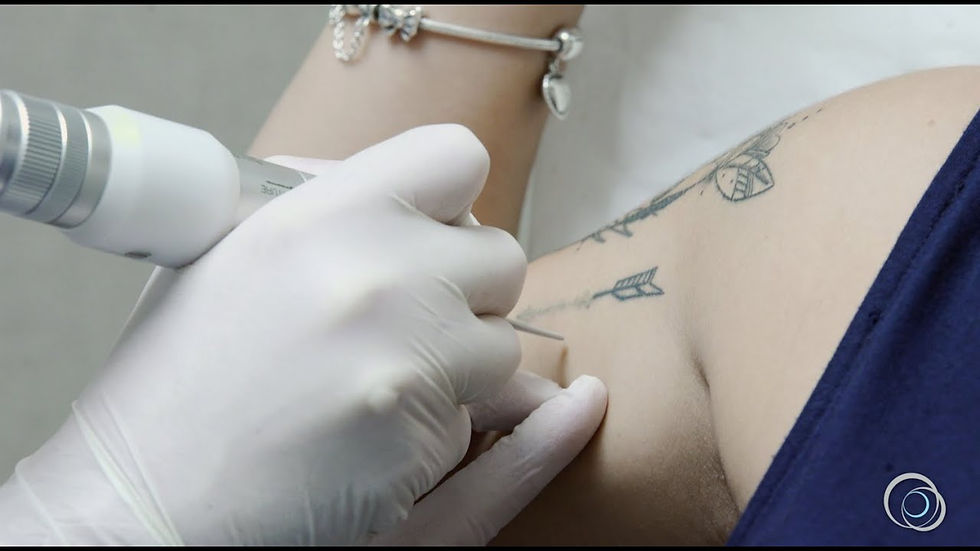Clearing Your Skin with Laser Tattoo Removal Methods
- danyalmalikdynamic
- Sep 25, 2024
- 4 min read
Tattoos have become increasingly popular in recent years, with many individuals opting for body art as a form of self-expression. However, as trends change or personal preferences evolve, the desire to remove unwanted tattoos has grown significantly. Tattoo Removal in Dubai is a viable solution for those looking to erase their ink. This article will explore various laser tattoo removal methods, their effectiveness, and considerations to keep in mind.
Understanding Laser Tattoo Removal
Laser tattoo removal is a medical procedure that uses focused light energy to break down the ink particles embedded in the skin. The body's immune system then gradually eliminates these smaller ink fragments, leading to the fading or complete removal of the tattoo. This method has gained popularity due to its precision and effectiveness compared to traditional tattoo removal techniques.

How Laser Tattoo Removal Works
The process begins with a consultation where a qualified professional assesses the tattoo, skin type, and medical history. The laser treatment itself involves several steps:
Preparation: The area around the tattoo is cleaned, and a topical anesthetic may be applied to minimize discomfort during the procedure.
Laser Application: The practitioner uses a specialized laser that emits pulses of light at specific wavelengths. Different colors of ink absorb different wavelengths, which is why multiple types of lasers may be used in a single session.
Post-Treatment Care: After the session, the treated area may appear red or swollen. Proper aftercare is crucial to ensure optimal healing and results.
Types of Lasers Used
There are several types of lasers commonly used for tattoo removal, each designed to target specific ink colors and types.
Q-Switched Lasers
Q-switched lasers are the most widely used in tattoo removal procedures. These lasers work by delivering short pulses of high-intensity light, which effectively breaks down the ink without damaging the surrounding skin. They can treat various ink colors, making them suitable for most tattoos.
PicoLasers
PicoLasers represent the latest advancement in tattoo removal technology. They deliver energy in picoseconds (trillionths of a second), allowing for faster and more efficient ink fragmentation. This method typically requires fewer sessions and may result in less discomfort during the treatment.
Factors Affecting Tattoo Removal
The success of tattoo removal in Dubai can vary based on several factors:
Ink Color: Some colors are easier to remove than others. For instance, black ink tends to respond well to laser treatment, while colors like green and blue can be more challenging.
Tattoo Age: Older tattoos may fade more easily compared to newer ones, as the body's immune system has had more time to break down the ink particles.
Skin Type: The effectiveness of the treatment can also depend on the patient's skin type and tone. Lighter skin tones may respond better to laser treatment than darker ones.
Location of the Tattoo: Tattoos located on areas with less blood flow, such as the extremities, may take longer to remove compared to those on the torso.
Number of Sessions Required
The number of sessions needed for effective tattoo removal varies depending on the factors mentioned above. On average, individuals may require anywhere from 5 to 15 sessions to achieve optimal results. Each session is typically spaced 6 to 8 weeks apart to allow the skin to heal and the immune system to eliminate the ink particles.
Aftercare Following Laser Tattoo Removal
Proper aftercare is essential for ensuring the best possible outcome from tattoo removal treatments. After each session, it is important to:
Keep the Area Clean: Gently cleanse the treated area with mild soap and water to prevent infection.
Avoid Sun Exposure: Protect the skin from direct sunlight by wearing clothing over the area or applying a broad-spectrum sunscreen.
Moisturize: Keeping the skin hydrated can aid in the healing process. Use a gentle, fragrance-free moisturizer as recommended by your practitioner.
Avoid Scratching: It is normal for the treated area to itch as it heals. However, scratching can lead to scarring and infection, so it is important to resist the urge.
Potential Side Effects
While laser tattoo removal is generally safe, there can be some side effects, including:
Redness and swelling in the treated area
Blistering or scabbing
Changes in skin pigmentation
Scarring (though this is rare with proper care)
Discussing these potential side effects with a qualified practitioner during the consultation is crucial to set realistic expectations for the outcome of the treatment.
Choosing a Tattoo Removal Specialist in Dubai
When seeking tattoo removal in Dubai, selecting a qualified and experienced practitioner is vital. Consider the following when making your choice:
Qualifications and Experience: Look for a specialist with a background in dermatology or cosmetic procedures. Ask about their experience specifically in laser tattoo removal.
Before and After Photos: Request to see before and after photos of previous clients. This can help gauge the effectiveness of their work.
Client Reviews: Research reviews and testimonials from former patients to understand their experiences.
Consultation: A reputable practitioner should provide a thorough consultation, discussing expectations, treatment options, and potential risks.
Conclusion
Tattoo removal in Dubai has become increasingly accessible and effective, particularly through advancements in laser technology. Understanding the process, types of lasers, and aftercare is crucial for achieving the best results. Whether motivated by changing personal aesthetics or professional considerations, individuals seeking to remove tattoos can find a solution that works for them. Always consult with a qualified specialist to ensure safety and effectiveness throughout the removal process.
Comments